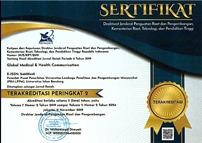Knowledge Level of Midwives before and after an Online Training Participation
Abstract
Keywords
Full Text:
PDFReferences
Saw SN, Low JYR, Mattar CNZ, Biswas A, Chen L, Yap CH. Motorizing and optimizing ultrasound strain elastography for detection of intrauterine growth restriction pregnancies. Ultrasound Med Biol. 2018;44(3):532–43.
Sharma D, Shastri S, Sharma P. Intrauterine growth restriction: antenatal and postnatal aspects. Clin Med Insights Pediatr. 2016;10:67–83.
Malhotra A, Allison BJ, Castillo-Melendez M, Jenkin G, Polglase GR, Miller SL. Neonatal morbidities of fetal growth restriction: pathophysiology and impact. Front Endocrinol (Lausanne). 2019;10:55.
American College of Obstetricians and Gynecologists' Committee on Practice Bulletins—Obstetrics and the Society forMaternal-FetalMedicin. ACOG Practice Bulletin No. 204: fetal growth restriction. Obstet Gynecol. 2019;133(2):e97–109.
Englund-Ögge L, Brantsæter AL, Juodakis J, Haugen M, Meltzer HM, Jacobsson B, et al. Associations between maternal dietary patterns and infant birth weight, small and large for gestational age in the Norwegian Mother and Child Cohort Study. Eur J Clin Nutr. 2019;73(9):1270–82.
Cano-Ibáñez N, Martínez-Galiano JM, Amezcua-Prieto C, Olmedo-Requena R, Bueno-Cavanillas A, Delgado-Rodríguez M. Maternal dietary diversity and risk of small for gestational age newborn: findings from a case-control study. Clin Nutr. 2020;39(6):1943–50.
Aghajafari F, Nagulesapillai T, Ronksley PE, Tough SC, O'Beirne M, Rabi DM. Association between maternal serum 25-hydroxyvitamin D level and pregnancy and neonatal outcomes: systematic review and meta-analysis of observational studies. BMJ. 2013;346:f1169.
Tian Y, Ye Y, Zhang Y, Dou L, Dou Y, Zhao P, et al. Maternal serum 25-hydroxyvitamin D concentrations during pregnancy and infant birthweight for gestational age: a three-cohort study. Pediatr Allergy Immunol. 2021;32(8):1637–45.
Jensen ME, Camargo CA Jr, Harvey SM, Gibson PG, Murphy VE. Serum 25 hydroxyvitamin D levels during pregnancy in women with asthma: associations with maternal characteristics and adverse maternal and neonatal outcomes. Nutrients. 2020;12(10):2978.
Hong-Bi S, Yin X, Xiaowu Y, Ying W, Yang X, Ting C, et al. High prevalence of vitamin D deficiency in pregnant women and its relationship with adverse pregnancy outcomes in Guizhou, China. J Int Med Res. 2018;46(11):4500-5.
Pereira-Santos M, Queiroz Carvalho G, David Couto R, Barbosa Dos Santos D, Marlucia Oliveira A. Vitamin D deficiency and associated factors among pregnant women of a sunny city in Northeast of Brazil. Clin Nutr ESPEN. 2018;23:240–4.
Yang C, Jing W, Ge S, Sun W. Vitamin D status and vitamin D deficiency risk factors among pregnancy of Shanghai in China. BMC Pregnancy Childbirth. 2021;21(1):431.
Emmerson AJB, Dockery KE, Mughal MZ, Roberts SA, Tower CL, Berry JL. Vitamin D status of white pregnant women and infants at birth and 4 months in North West England: a cohort study. Matern Child Nutr. 2018;14(1):e12453.
Dawodu A, Akinbi H. Vitamin D nutrition in pregnancy: current opinion. Int J Womens Health. 2013;5:333–43.
Schöttker B, Ball D, Gellert C, Brenner H. Serum 25-hydroxyvitamin D levels and overall mortality. A systematic review and meta-analysis of prospective cohort studies. Ageing Res Rev. 2013;12(2):708–18.
Ruiz JG, Mintzer MJ, Leipzig RM. The impact of e-learning in medical education. Acad Med. 2006;81(3):207–12.
Huynh R. The role of e-learning in medical education. Acad Med. 2017;92(4):430.
Frehywot S, Vovides Y, Talib Z, Mikhail N, Ross H, Wohltjen H, et al. E-learning in medical education in resource constrained low- and middle-income countries. Hum Resour Health. 2013;11:4.
George PP, Papachristou N, Belisario JM, Wang W, Wark PA, Cotic Z, et al. Online eLearning for undergraduates in health professions: a systematic review of the impact on knowledge, skills, attitudes and satisfaction. J Glob Health. 2014;4(1):010406.
Gegenfurtner A, Zitt A, Ebner C. Evaluating webinar-based training: a mixed methods study of trainee reactions toward digital web conferencing. Int J Train Dev. 2020;24(1):5–21.
Black AT, Clauson M, Fraser S. Evaluation of a webinar-based education strategy to engage nurses and support practice. J Nurses Prof Dev. 2013;29(5):249–54.
Cunningham M, Elmer R, Rüegg T, Kagelmann C, Rickli A, Binhammer P. Integrating webinars to enhance curriculum implementation: AMEE Guide No. 136. Med Teach. 2021;43(4):372–9.
Rana R, Kumawat D, Sahay P, Gour N, Patel S, Samanta R, et al. Perception among ophthalmologists about webinars as a method of continued medical education during COVID‑19 pandemic. Indian J Ophthalmol. 2021;69(4):951–7.
Othman SME, Steen M, Fleet JA, Jayasekara R. Healthy eating in pregnancy, education for midwives: a pre-post intervention study. Eur J Midwifery. 2020;4:20.
Serebrakian AT, Ortiz R, Christensen JM, Pickrell BB, Irwin TJ, Karinja SJ, et al. Webinar during COVID-19 improves knowledge of changes to the plastic surgery residency application process. Plast Reconst Surg Glob Open. 2020;8(10):e3247.
Rahmati R, Khadivzadeh T, Esmaily H. Comparison of the effect of two training methods (webinar and group discussion) on improving the attitude and performance of health workers in providing counseling with fertility promotion approach. J Edu Health Promot. 2020;9:280.
McKinney WP. Assessing the evidence for the educational efficacy of webinars and related internet-based instruction. Pedagogy Health Promot. 2017;3(15):47S–51S.
Hosseini SMR, Mahmodi MA, Mirhaghi A. Evaluation of the impact of webinar training in comparison to conventional training on COVID-19 risk perception in emergency medical technicians. Mod Care J. 2021;18(2):e116139.
Ismail II, Abdelkarim A, Al-Hashel JY. Physicians’ attitude towards webinars and online education amid COVID-19 pandemic: when less is more. PLoS One. 2021;16(4):e0250241.
DOI: https://doi.org/10.29313/gmhc.v10i3.9602
pISSN 2301-9123 | eISSN 2460-5441
Visitor since 19 October 2016:
Global Medical and Health Communication is licensed under a Creative Commons Attribution-NonCommercial-ShareAlike 4.0 International License.































.png)
_(1).png)
_(1).jpg)
